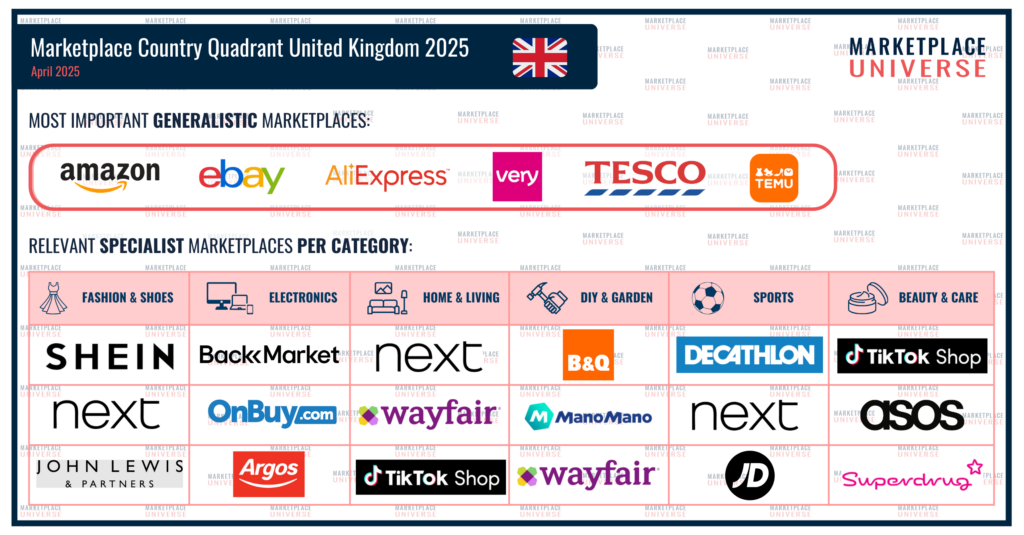
These are the 24 most important B2C marketplaces in the UK!
The UK remains one of Europe’s most mature e-commerce markets—diverse, competitive, and packed with opportunity. With its early adoption of online retail and high digital penetration, the country has cultivated both local champions and an appetite for international platforms. In this new Marketplace Country Quadrant, we take a close look at the most relevant marketplaces in the UK for 2024.
The UK is home to around 66 million people, with an average net household income of €25,952 and a VAT rate of 20%. In 2023, e-commerce generated a turnover of $160 billion, growing by 3.9% compared to the previous year. Online now accounts for 30% of total retail, with 45% of online sales estimated to take place via marketplaces. Traffic data shows that Amazon alone reaches roughly 70% of the UK’s online population each month.
But while the UK is digitally advanced, Brexit has significantly reshaped the landscape: import duties, new VAT regulations, and stricter rules on logistics and returns have created real hurdles for cross-border trade from the EU. Many marketplaces in the UK no longer accept EU-based sellers or do so only under specific conditions. Despite these barriers, a rich and highly competitive marketplace ecosystem continues to thrive—especially for UK-based sellers.
The Leading Generalist Marketplaces in the UK
The generalist segment of marketplaces in the UK is led by Amazon, the undisputed number one. It dominates across almost all retail categories and has cemented itself as the first port of call for British consumers. eBay remains a key marketplace, especially for electronics and refurbished goods. AliExpress has gained traction with price-sensitive consumers and remains a relevant choice for specific product segments.
Local players also hold strong ground: Tesco and Very both operate full-range online shops with integrated marketplaces, making them powerful generalists across grocery, electronics, fashion, and home. A more recent disruptor is Temu, which, much like in Germany and France, has gained fast adoption in the UK and now addresses a wide range of categories with aggressive pricing and visibility strategies.
Specialist Marketplaces in the UK by Category
Fashion
Fashion is one of the UK’s most dynamic e-commerce segments. Shein leads in fast fashion and younger demographics, while Next combines own-brand retail with marketplace functionality across mid-range and family fashion. John Lewis offers a more premium assortment and strong customer trust. Asos remains relevant, especially for younger consumers drawn to trend-focused brands, and Zalando, though less dominant post-Brexit, is still important for EU brands already connected to the platform.
Electronics
While Amazon and eBay are crucial for electronics, three specialist marketplaces in the UK also stand out: BackMarket, with a strong focus on refurbished tech; OnBuy, the UK-founded marketplace with a growing generalist profile and strength in electronics; and Argos, a well-established UK retailer with a significant online electronics offering.
Home & Living
This segment shows an interesting blend of legacy and innovation. Next leads with a trusted home offer, while Wayfair continues to hold significant market share, particularly in furniture and garden categories. TikTok Shop is emerging rapidly in this space—its content-driven discovery model is starting to influence consumer behavior in home décor and impulse purchases.
DIY & Garden
DIY and garden are traditional strengths in the UK market. B&Q, part of the Kingfisher group, remains one of the most trusted players in this space. ManoMano, a French online pure player long active in the UK, complements this with a digital-first approach. Wayfair plays a role especially in garden furniture, while TikTok Shop is catching up fast, thanks to strong traction for trending tools and small-format products.
Sports
In sports, Decathlon continues to dominate with a clear brand focus and wide assortment. Next also plays a role in the sportswear segment, while JD Sports remains one of the UK’s leading multi-brand platforms for performance and streetwear.
Beauty & Care
The beauty category is undergoing a transformation. TikTok Shop has become one of the most important marketplaces in the UK for beauty brands, from indie cosmetics to viral skincare. Asos also plays a role in beauty, particularly among younger consumers. Superdrug, unlike competitor Boots (which shut down its marketplace model), has embraced third-party selling with a dedicated marketplace for beauty and personal care products.
The UK’s Marketplace Dynamics
The UK combines early digital maturity with recent structural change. Brexit has had a massive impact, creating significant friction for EU-based marketplace sellers due to new VAT rules, customs duties, and complicated returns. As a result, many marketplaces in the UK are closed to non-UK sellers or only tentatively opening up, often requiring warehousing or VAT registration in the UK.
This isolation has benefited UK-born platforms like OnBuy and Very, and accelerated the success of UK-facing global players like Amazon, Shein, and Temu. Meanwhile, Zalando and other EU-based marketplaces have struggled to maintain relevance in the UK market.
Despite the challenges, the UK remains a mature, high-volume market with active shoppers and a strong appetite for both low-cost offers and premium experiences. Whether you’re selling fashion, refurbished tech, or trending beauty items, the marketplace infrastructure is in place—and evolving rapidly.
Do you have anything to add to our country quadrant for the UK? Let us know!
Interested in a different country or a specific product category? Check out all our quadrants here!